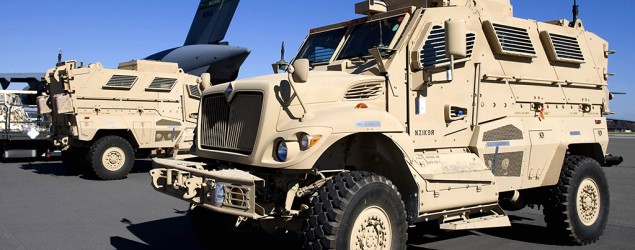
(Department of Defense/Yahoo News)
That’s because a 45,000-pound, explosion-resistant vehicle from the wars in Iraq and Afghanistan might spoil the mood.
Shellmyer, a 78-year-old city councilman for the small town of Washington, Iowa, was the sole local politician to vote against the department of 12 police officers getting the free MRAP — short for mine-resistant, ambush-protected vehicle — from the Defense Department three months ago. Washington is one of hundreds of towns and cities to get a recycled MRAP from the Pentagon over the past year and a half.
“Here’s the thing,” Shellmyer says. “Washington, Iowa, has 8,000 people. We have an MRAP now. We have a SWAT team. We have [police] dogs, and we have a SWAT team transportation vehicle that’s not armored.”
The city councilman began to think: “Goodness, this is overkill.”
But as a new report by the ACLU demonstrates, Washington’s use of military tactics and equipment has become the norm. Most of America’s police departments now have special paramilitary units — called SWAT teams — to respond to emergency situations, conduct drug raids and even, in some cases, patrol the streets. In the past few years, more of these SWAT teams are getting armored vehicles provided by the federal government to expand their capabilities.
Law enforcement leaders say the increased military equipment and tactics are necessary to respond to violent emergency events such as school shootings. Critics counter that the militarization of police causes needless violence. The ACLU report found that 46 civilians were injured in 818 SWAT raids over two years in 11 states. Children were present in the home in 14 percent of the raids the group studied. In 60 percent of the raids, police had a search warrant for a drug offense. Only 7 percent of the SWAT deployments the ACLU studied were for hostage or active shooter scenarios.
The MRAPs, designed to protect
U.S. soldiers from roadside bombs in Iraq and Afghanistan, are now
providing more firepower to these raids thanks to the Defense
Department’s 1033 program, which began in the late 1980s to recycle old
military equipment to local police. (That includes tens of thousands of
machine guns, as well as more quotidian items such as office furniture
and computers.) The Department of Homeland Security, meanwhile, provides
millions of dollars in grants to local police to buy lighter armored
vehicles, like BearCats, to combat terrorism or drug running. (Keene,
New Hampshire, received a DHS grant on the strength of an application
that listed its annual pumpkin festival as one of several potential
terrorist targets.)
Unlike when they apply for DHS
grants, police departments do not have to make the case that they are
facing a terror threat to receive an MRAP under the Defense Department
program. The Pentagon has given away 600 MRAPs since it began unloading
the vehicles last year. The demand for the hulking machines is growing.




No comments :
Post a Comment